Now Reading: Top 10 Best Places to Visit in Sukhothai – Temples, Culture & Nature
-
01
Top 10 Best Places to Visit in Sukhothai – Temples, Culture & Nature
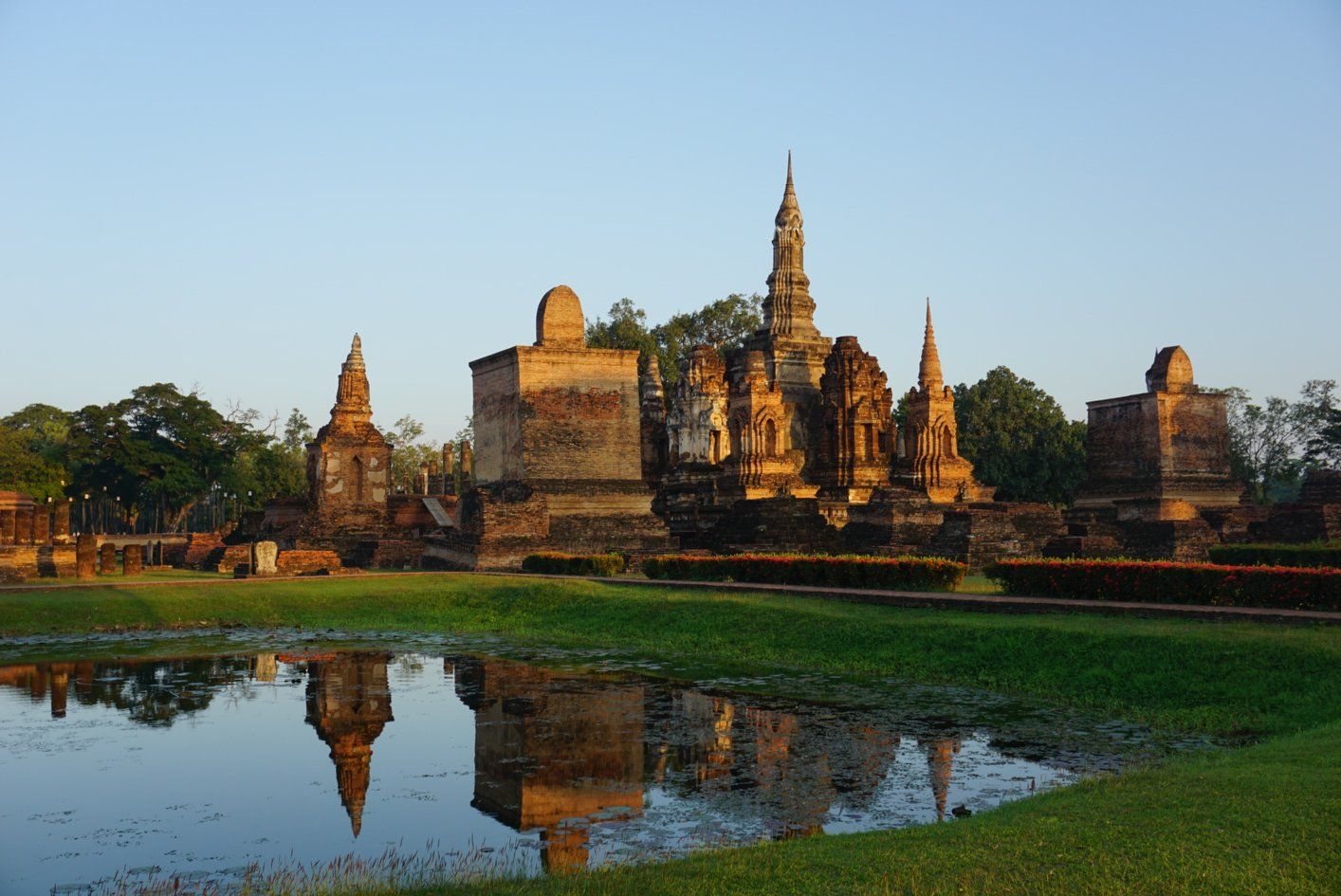
Top 10 Best Places to Visit in Sukhothai – Temples, Culture & Nature
1.Sukhothai Historical Park
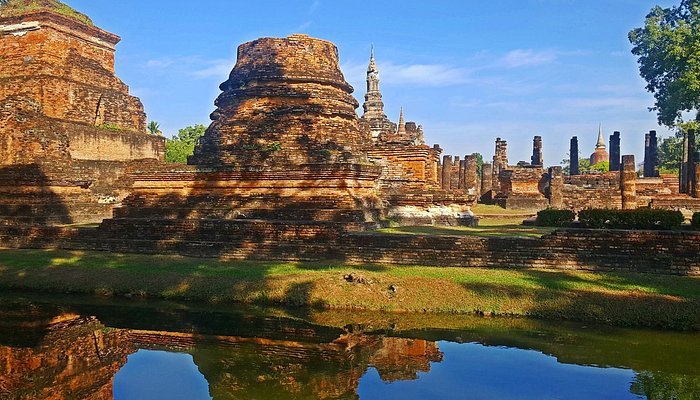
Discover Thai history at Sukhothai Historical Park.
Situated at the northern end of Thailand, Sukhothai Historical Park is like a living museum, allowing visitors to experience the 13th and 14th century heights of Thai civilization. Because it was the capital of Sukhothai, this World Heritage Site is viewed as the creator of Thai culture, art and language.
Situated on more than 70 kilometers, the park brings together the ruins of royal palaces, Buddhist temples, city gates, moats, walls and a carefully designed water management network that shows the skill of ancient Thai engineers. As you wander through the park on foot or a bicycle, you’ll see more than 190 well-preserved or restored monuments from history.
You Won’t Want to Miss These:
- Temple of the Buddhist monastery – An important site in Sukhothai with tall Buddha statues and interesting chedis.
- Wat Si Chum – Known for its huge seated Buddha statue surrounded by a narrow mandapa and amazing to see.
- Wat Sa Si – A beautiful temple sit on an island in the middle of a pond covered with many lotuses.
- Not far from the park, Ramkhamhaeng National Museum gives more details about Sukhothai’s past.
Visitor Info:
- Mueang Sukhothai District, Sukhothai Province in Thailand
- You may visit the facility from 6:30 AM until 7:30 PM.
- Central, north and west zone prices for admission are all about 100 Baht; you can rent a bike at the complex.
2.Boon Lott’s Elephant Sanctuary
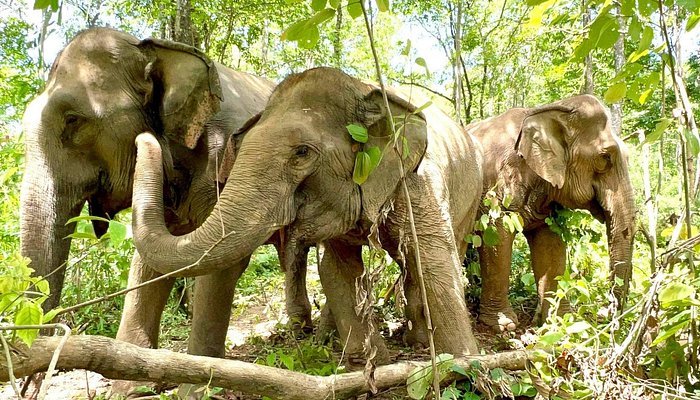
Set in the peaceful northern Thailand countryside, Boon Lott’s Elephant Sanctuary (BLES) works hard to save and heal elephants and other critical animals. In 2006, some animal-lovers set up this family oasis to give these remarkable creatures comfort and space to live at ease.
BLES has much greater functions than just being an elephant sanctuary. The team is dedicated to conserving nature, by keeping local forests safe from cutting and guarding the habitats that elephants and other animals depend on. With environmental protection, BLES supports the health and future of its people and all living things.
Three independent elephants meet.
Elephants at BLES are part of the family. A lot of these large animals are saved after experiencing tragedy, exploitation, injury or being abandoned by people. At this facility, injured animals receive the care, room and love necessary for healing. People who come here can watch the elephants and, in a safe way, help or interact with them.
Every Creature is Included
While the sanctuary is centered on elephants, BLES also tries to help any other animal in need, including dogs, cats and birds. This environment is friendly and makes every life important.
- The sanctuary is located at Boon Lott’s in Sukhothai Province, Thailand
- anytime of year is possible, but the weather is most enjoyable during the cooler months from November to February
- Cleaning and safety appointments are the only way to ensure the animals experience no stress and the park is peaceful.
3.Wat Mahathat
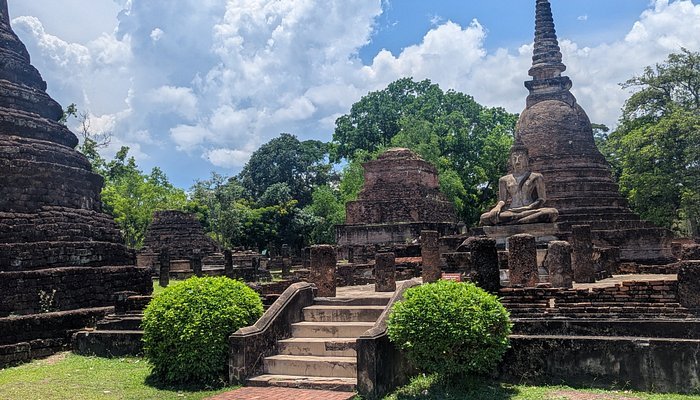
The biggest and most beautiful temple of Sukhothai, Wat Mahathat, is found just behind Sukhothai Historical Park’s famous Royal Palace. This temple is a true showcase of Thailand’s history and everyone interested in these areas should visit it.
Wat Mahathat once served as the spiritual heart of the kingdom and now marks how impressive the art and religion were during that period. On the temple grounds, you can see the fine architectural style of Sukhothai which blends harmony in form with detailed patterns.
The temple’s most famous artifact is the huge bronze statue of Buddha, made by King Lithai of Sukhothai in 1362. This sculpture represents the stylish and spiritual calmness of art from Sukhothai. This masterpiece proves the high level of Buddhist artwork early in Thai history.
Guests may walk the temple grounds, admire the ancient chedis (stupas), enjoy the lotus-shaped bases and discover what’s left of the old buildings from Sudhthai’s golden era. With everything so peaceful, it makes it easy to notice and appreciate Thai culture and religion.
- Behind the Royal Palace is where you’ll find the Sukhothai Ruins, at the Sukhothai Historical Park in Sukhothai, Thailand.
- 🕚 The Best Time to Tour: Early in the morning or late in the afternoon for cool air and softer lighting that’s good for photographers
- Only 1 ticket is needed for Sukhothai Historical Park and Sukhothai Ethiopian Museum.
4.Si Satchanalai Historical Park
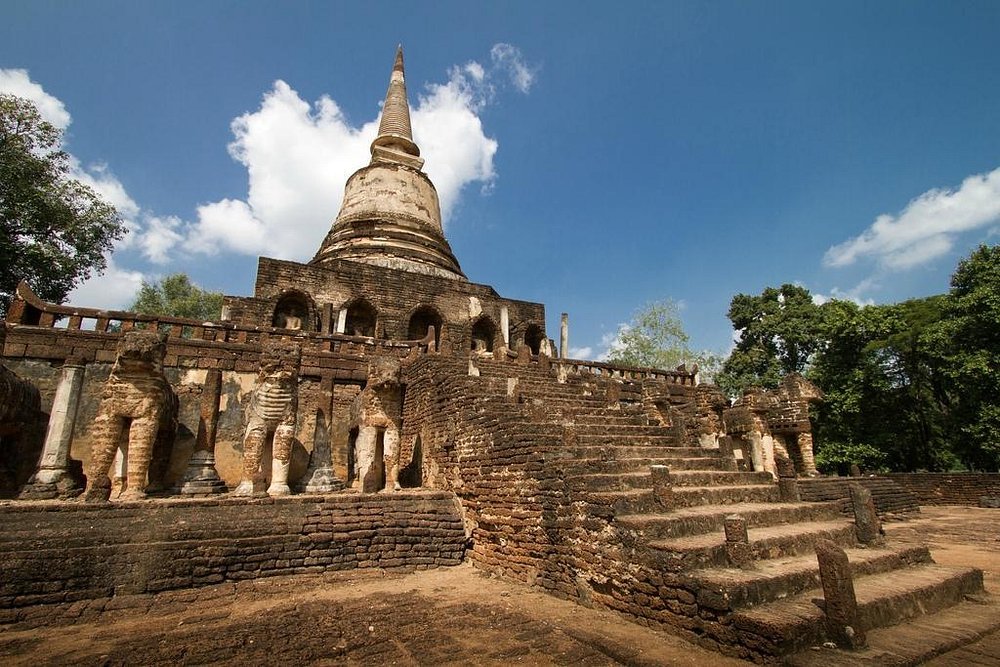
Located by the quiet Yom River, Si Satchanalai Historical Park lets visitors see the history of Thailand. Originally referred to as “Muang Chaliang,” this old city was very active when Thailand was ruled by the Sukhothai Kingdom and now keeps many ruins from that culture.
In Si Satchanalai, travelers can see more than 134 monuments, belonging to grand temples, detailed chedis and Buddha statues too. Every design shows the impressive building skills, faith and cultural life of people who were here long ago.
Wandering across the huge property, you can find Wat Chedi Chet Thaeo, Wat Nang Phaya and Wat Chang Lom among the temples. At the ruins, you can find stucco walls, well-preserved Buddha statues and brickwork that illustrates classic Sukhothai architecture with local touches.
Being around the Yom River makes the place even more peaceful for your history tour. Since both the unique nature and the abandoned places create a perfect environment for relaxation, tourists also come to think and explore.
- 📍 Located in Sukhothai Province’s Si Satchanalai District, Thailand
- Going in the morning or late afternoon will give you a pleasant visit and some peace.
- Tickets needed and usually given with access to Sukhothai Historical Park
5.Wat Si Chum
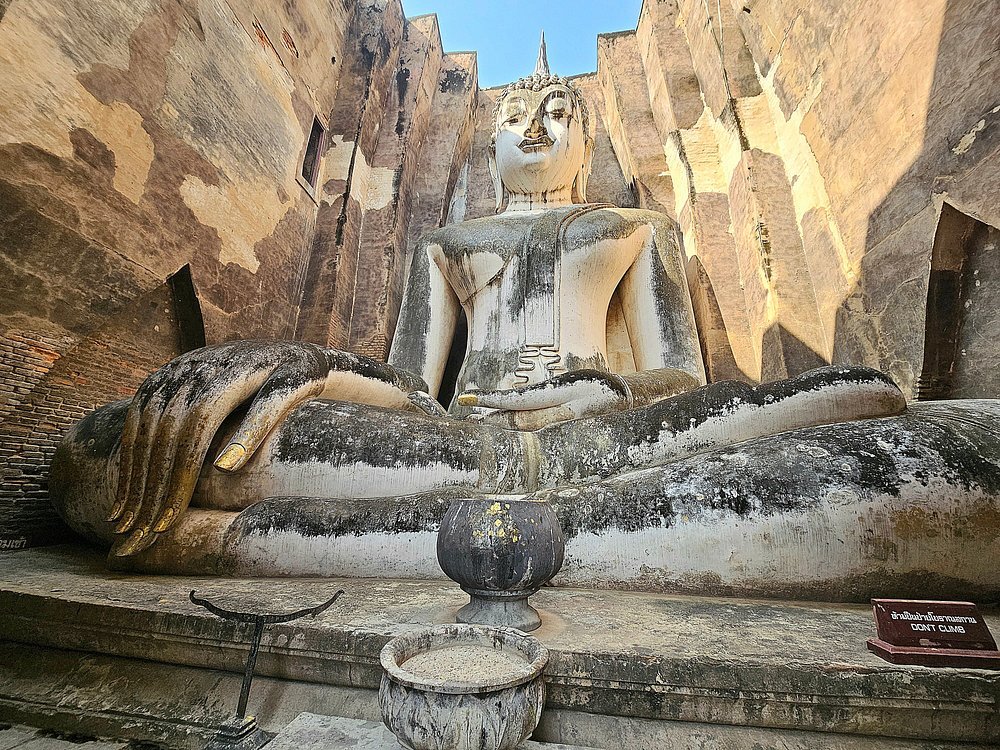
In the ancient Sukhothai area, Wat Si Chum is celebrated for its huge and beautiful Buddha image. People are amazed by its spiritual mood and the unique design of its architectural features.
At the center of the temple is Phra Achana, a huge statue of seated Buddha, inside a huge mondop (reliquary). The hand in this statue which reaches all the way to the waist, represents how fearless and protective the Buddha is.
People enter the mondop through a small opening, so they see the Buddha’s face surrounded by mystery. Because of this careful design, the Buddha appears to look kindly and deeply at anyone who enters.
The area’s importance comes from its history and old architecture.
Wat Si Chum dates to the Sukhothai period and represents the artistic and religious highpoint of these times. Standing before the temple and Buddha makes most people feel calm and respectful. A lot of history and spirituality merge there in beautiful ways.
🌅 Best Season to Go
The best times to ensure you won’t be crowded and the temple atmosphere is peaceful are early mornings and late afternoons.
- Sukhothai Historical Park in Thailand’s Sukhothai Province
- Opening hours each day are usually from 8:00 AM to 5:00 PM.
- 🎟️ Visiting the area is covered with the ticket to Sukhothai Historical Park
6.Sukhothai Loi Krathong and Candle Festival
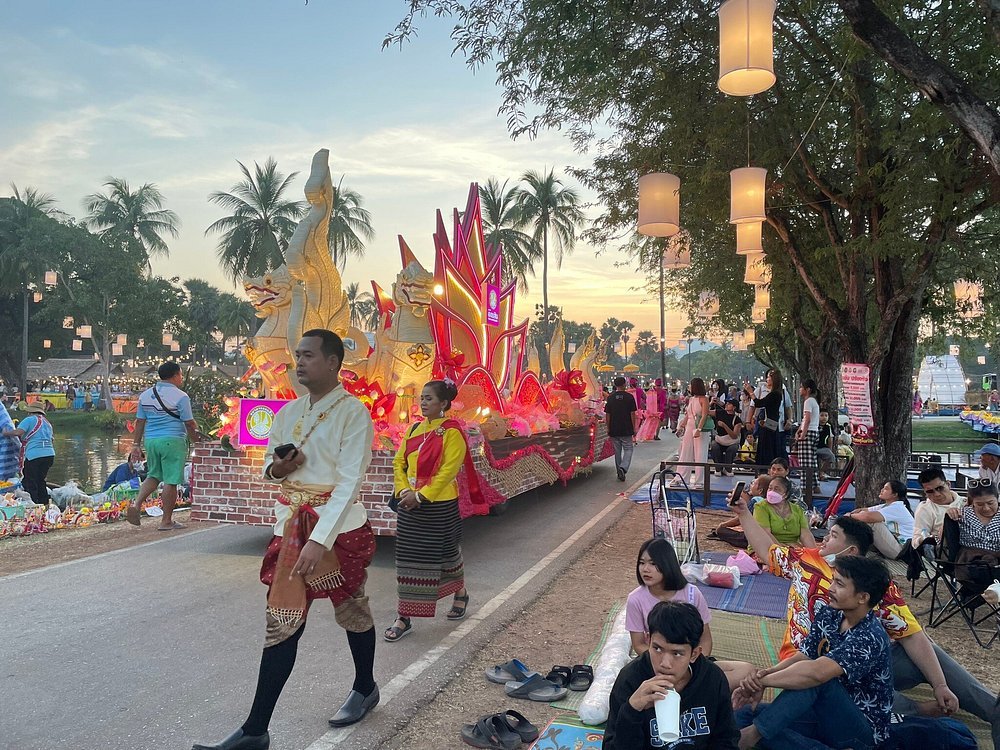
Once a year, usually in November when the full moon falls in the 12th month of the lunar calendar, Thailand celebrates the festival of Loi Krathong. Although Loi Krathong is celebrated everywhere in Thailand, many consider Sukhothai, where it first originated, to be an especially special place to see the festival.
Five Days of Celebrations in Thailand’s Historic Center
For most of the five days, the festival takes place around and within the ruins of Sukhothai Historical Park.
The most interesting part of the festival is the lovely floating of the handmade krathongs. Candles are put onto the water to express a desire to let go of what’s gone and wish for what’s upcoming. Even as krathongs are taken to the water, many lanterns are launched to fill the night sky with bright lights.
It’s easy to see the ruins thanks to the spectacular fireworks in the evenings. Folk and cultural performances in Ancient City use colorful clothes and traditional tunes to show Thailand’s cultural past.
- 📍 Succeeded in Thailand’s capital city, Sukhothai Provincial Park.
- Over five days, there are uninterrupted celebrations all through the full moon period.
- Festivals at the park generally take place with the park admission.
7.Wat Sri Sawai
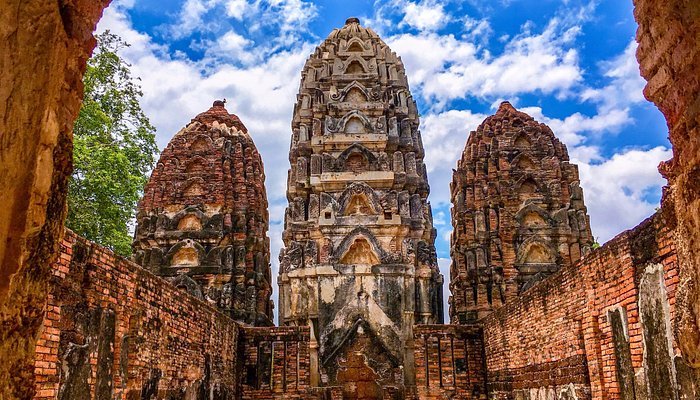
Even though Sukhothai Historical Park is best known for its wonderful Buddhist temples, Wat Sri Sawai is notable because it has a strong Hindu background and stands out in these ancient ruins.
It is thought that Wat Sri Sawai began as a Hindu shrine and was converted to a Buddhist temple. The buildings at Phnom Penh display how people from India, China and other countries have joined, especially the Khmer-style towers that point to the temple’s Hindu past.
Historic Significance
Built in the early period of Sukhothai, this temple reflects the many religions present and influencing this region. Hindu deities are carved into the well-preserved prangs which make Wat Sri Sawai an attractive location for those appreciating history and architecture.
- Sukhothai Historical Park, Sukhothai Province, Thailand
- The best time to go is in the early morning or late afternoon when it isn’t too warm and the light is gentle.
8.Wat Saphan Hin

On a hilltop, Wat Saphan Hin gives people a look at Buddhist history and a beautiful view of the Sukhothai Historical Park area.
Since the way to Wat Saphan Hin includes steps made of stone, you should put on shoes that are clean and firm, as concrete can become very slippery. It costs 100 Baht to enter, plus you pay an extra 10 Baht if you ride a bike inside. All your hard work pays off when you stand at the top!
Right at the top, a large seated Buddha statue can be seen; it is both serene and amazing to see. Being situated high on the mountain, you can look out over the many ancient sites and the extensive greenery in all directions.
Safety Note
Although wardens and patrol cars look after visitors during the day, you should still visit only when there’s plenty of daylight. Wat Saphan Hin shuts at 5 PM and no guards are on duty in the evening. In 2007, a serious incident happened, so security at the site and road is now very tight with guards in place. It results in a safe experience for everyone who visits the building.
- 🌞 Most Recommended Time to Visit
- Make your trip in the daytime, so you can enjoy both the place and the scenery and have peace of mind. While the incident was in the morning, the place is now safe to visit during official times.
- Sukhothai Historical Park in the Sukhothai Province of Thailand is the place it is located.
- The entrance charge for Monkey Hill is 100 Baht and it’s 10 Baht extra for parking bikes.
9.Wat Sa Si
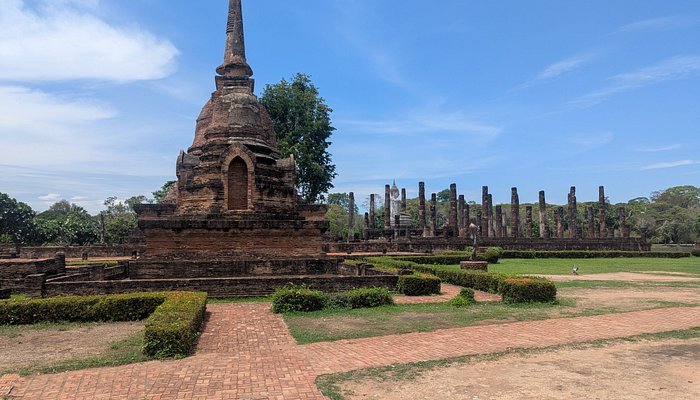
Placed gently between lotus-laden waters in Sukhothai, Wat Sa Si is one of the city’s most beautiful and emotional temples. A visit here makes you feel like you’re reading a storybook, bringing together landscape, history and spirituality.
A major attraction to the temple is its resplendent seated Buddha statue, set between two ancient columns. Because the temple sits above the water’s glassy surface, it looks like it is floating and when the lake is peaceful, the Buddha and pillars show perfectly in the stillness.
The peaceful environment in the temple is enhanced by the movement of lotus flowers, motivating visitors to enjoy the calmness. If you want to take some peaceful time or great photos, it is the place for that.
- 📍 Site: Sukhothai Historical Park, in Sukhothai Province, Thailand
10.Ramkhamhaeng National Museum
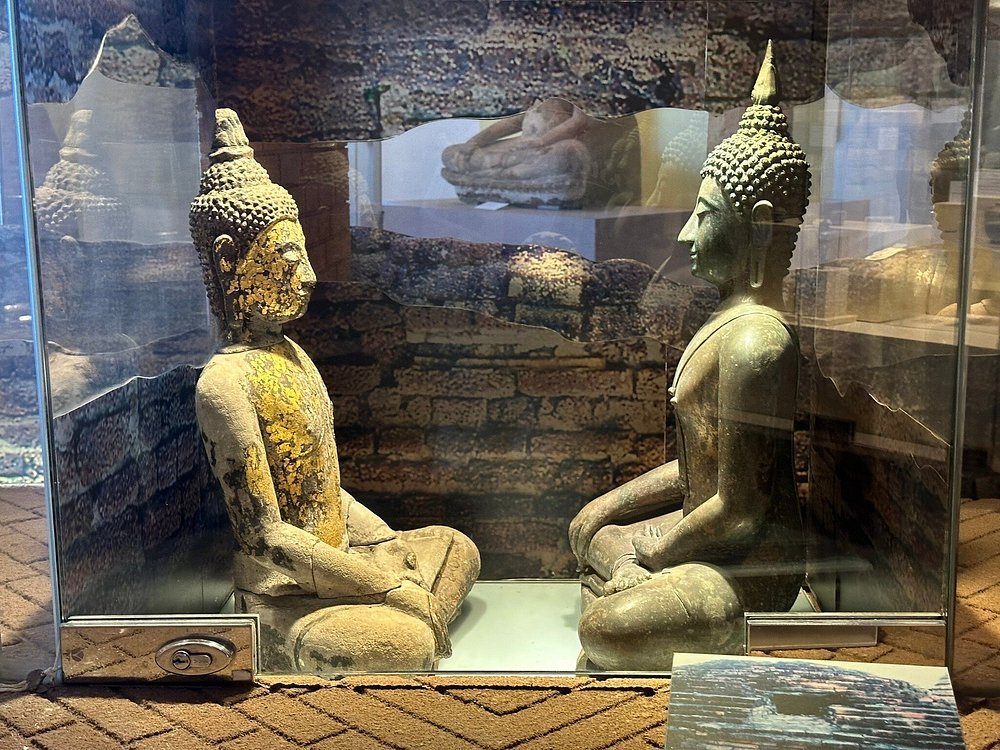
Ramkhamhaeng National Museum is a great place for anyone interested in art, history or exploring culture, as you can get to know the Sukhothai Kingdom’s past. Here you will find a wide range of outstanding art objects and antiques that express the unique qualities of Sukhothai style, an important time in Thai history.
Why Visit?
Anyone excited about early Buddhist artwork or interested in the history of Thai culture will find lots to explore at Ramkhamhaeng National Museum. It is an excellent addition to seeing the nearby historical park and learning more about Thailand’s glorious history.
- Sukhothai, Thailand is the location.
Related articles : Top 10 Best Places to Visit in Suphan Buri – Temples, Culture & Nature
Stay Informed With the Latest & Most Important News
Previous Post
Next Post
-
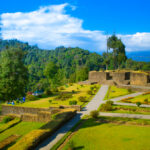 01Top 5 Best Places Visiting in Gyalshing – Monasteries, Lakes & Scenic Escapes
01Top 5 Best Places Visiting in Gyalshing – Monasteries, Lakes & Scenic Escapes -
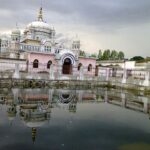 02Top 5 Best Places Visiting in Panna – Temples, Waterfalls & Wildlife Escapes
02Top 5 Best Places Visiting in Panna – Temples, Waterfalls & Wildlife Escapes -
 03Top 5 Best Places to Visit in Malerkotla – Malerkotla Fort, Sheesh Mahal & More
03Top 5 Best Places to Visit in Malerkotla – Malerkotla Fort, Sheesh Mahal & More -
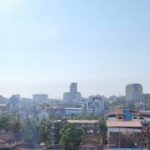 04Top 10 Best Places Visiting in Dakshina Kannad for Culture, Nature & Coastal Charm
04Top 10 Best Places Visiting in Dakshina Kannad for Culture, Nature & Coastal Charm -
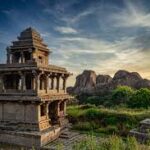 05Top 2 Best Places Visiting in Chitradurga for History, Nature & Adventure
05Top 2 Best Places Visiting in Chitradurga for History, Nature & Adventure -
 06Best Places Visiting in Shopian – Explore Top Attractions & Hidden Gems
06Best Places Visiting in Shopian – Explore Top Attractions & Hidden Gems -
 07Best Places Visiting in Narmadapuram – Temples, Waterfalls & Wildlife Escapes
07Best Places Visiting in Narmadapuram – Temples, Waterfalls & Wildlife Escapes












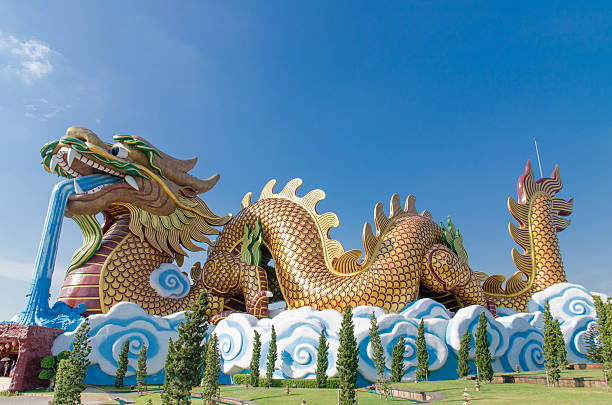
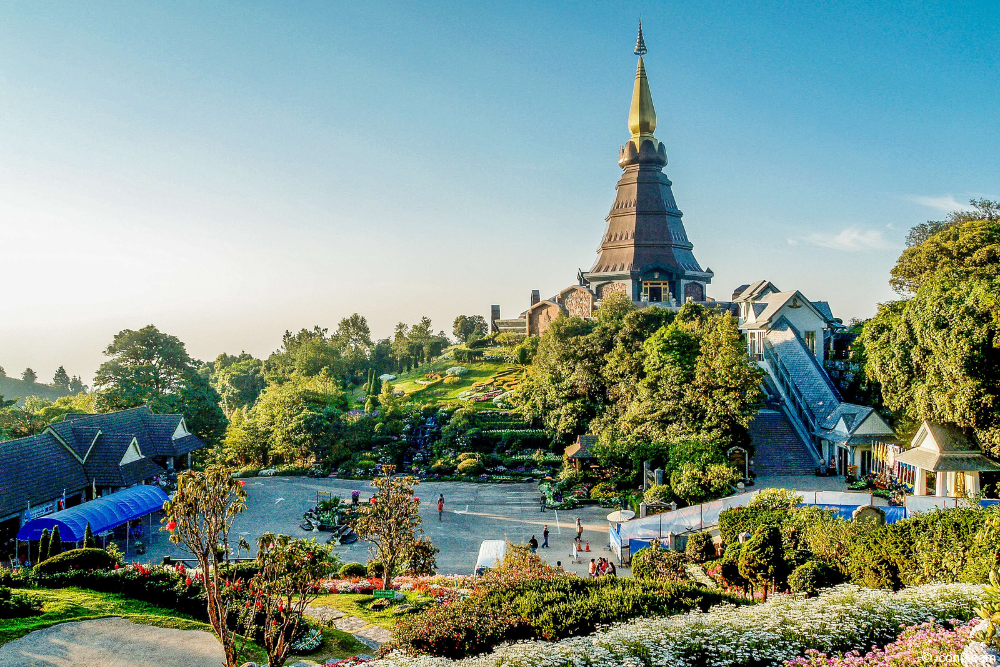
Pingback: Best Places to Visit in Songkhla – Explore Beaches, Culture & Nature